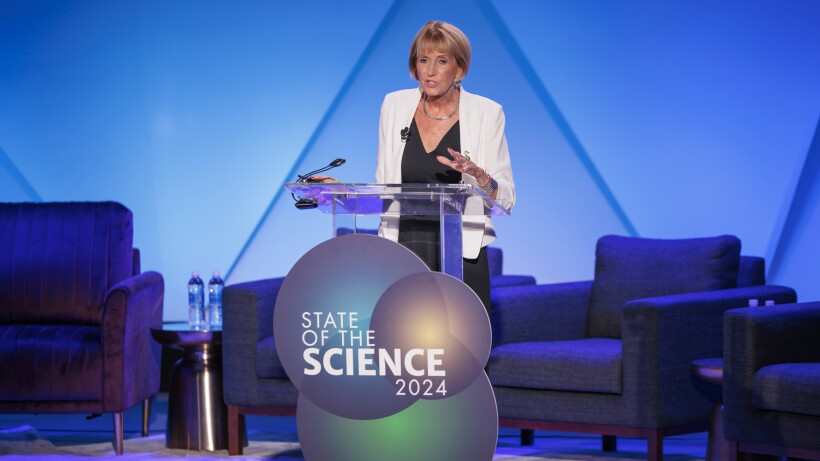Inaugural ‘State of the Science’ Speech Charts Headwinds Facing the US

Marcia McNutt delivered the State of the Science speech at the National Academy of Sciences building in Washington on June 26.
NAS
In the inaugural State of the Science address last month, National Academy of Sciences President Marcia McNutt argued the U.S. needs to reinforce its position as a leader in scientific research to ensure continued national security, economic security, and soft power on the global stage. McNutt made the case for a new era of societal support for science that she termed “The Endless Frontier 2.0,” a successor to Vannevar Bush’s post-World War II call to action for the government to nurture the scientific enterprise.
The speech represents a new bid by science community leaders to focus attention on challenges and opportunities facing the U.S. research enterprise. “Just as the annual State of the Union address gives Americans a sense of how the nation is doing on key priorities, I hope that the State of the Science address will provide policymakers and the public with a clear picture of the overall direction of the U.S. research enterprise,” McNutt said leading up to the event.
She opened the speech by noting that many Americans know little about scientists despite the historical strength of the U.S. research system. She observed how the U.S. holds 15% of all Olympic prizes in modern times but has won 60% of Nobel Prizes in STEM fields since the early 1900s, yet most Americans cannot name a single Nobel-prize-winning scientist while Olympic athletes are household names.
Despite this historical leadership in science, McNutt said the U.S. faces increasing competition from other countries, particularly China. She pointed out, for instance, that China passed the U.S. in annual patent production in 2015, in STEM doctorate production in 2018, and now is getting closer to surpassing the U.S. lead in overall R&D spending and the fraction of most cited research papers.
More broadly, McNutt suggested there have been several major shifts in the composition of the U.S. research enterprise that Bush did not anticipate when he published his 1945 treatise about the “endless frontier” of science. Among them is that the U.S. has become heavily dependent on foreign students to fill STEM occupations, which McNutt framed as both a risk and an opportunity.
Foreign students made up 43% of all science and engineering workers at the doctoral level in 2021, she said, citing data from the National Center for Science and Engineering Statistics. She also pointed out that 65% of foreign STEM students remain in the U.S. for at least 10 years after graduation.
“We literally couldn’t fill our STEM jobs if it were not for these foreign students coming and staying in the U.S.,” she said, while also noting that even the students who leave often present benefits by retaining close ties to the U.S. and raising standards of living in their home countries.
McNutt argued one of the biggest challenges facing the U.S. is to “build the scientific workforce of the future” amid growing competition for international talent and weaknesses in the U.S. K-12 education system.
“As foreign nations increase their investment in R&D, it’s going to be harder to get foreign students to come here to study here and to stay here. So, we have to start drawing on the full creativity of America, and we’re doing a really lousy job of that,” she said. The U.S. is being outperformed in math and science test scores by other advanced economies, with 40% of eighth-grade students not proficient in math, she said, citing NCSES data.
To make STEM careers a reality for more children across the country, she called for reinvigorating science curricula to better foster childhood curiosity. Further along the STEM workforce pipeline, she said the U.S. needs to “modernize rules of engagement” between academia and industry in part by providing corporate internship opportunities to students that supplement their stipends and make careers in science more financially viable. However, she warned that the need for STEM workers cannot be met by domestic education alone and urged the federal government to reduce obstacles for foreign students and scientists to come to the U.S.
McNutt also said that strengthening international partnerships is more necessary than ever, in part because the costs of state-of-the-art facilities are increasingly beyond the means of any one country. U.S. engagement with other countries can also shape global behavior, she said, pointing to how the Antarctic Treaty of 1959 has successfully preserved the continent for joint scientific purposes.
McNutt ended her speech by highlighting the challenge of cultivating public trust in science, which polling data suggests has dropped sharply since the pandemic.
“We’re not even going to keep federal funding for science at the same level it is today if we don’t bring the public along with us,” she said. “We have to support excellence in communicating science to the public. If we stay in our ivory towers, we’re not going to win their support.”



